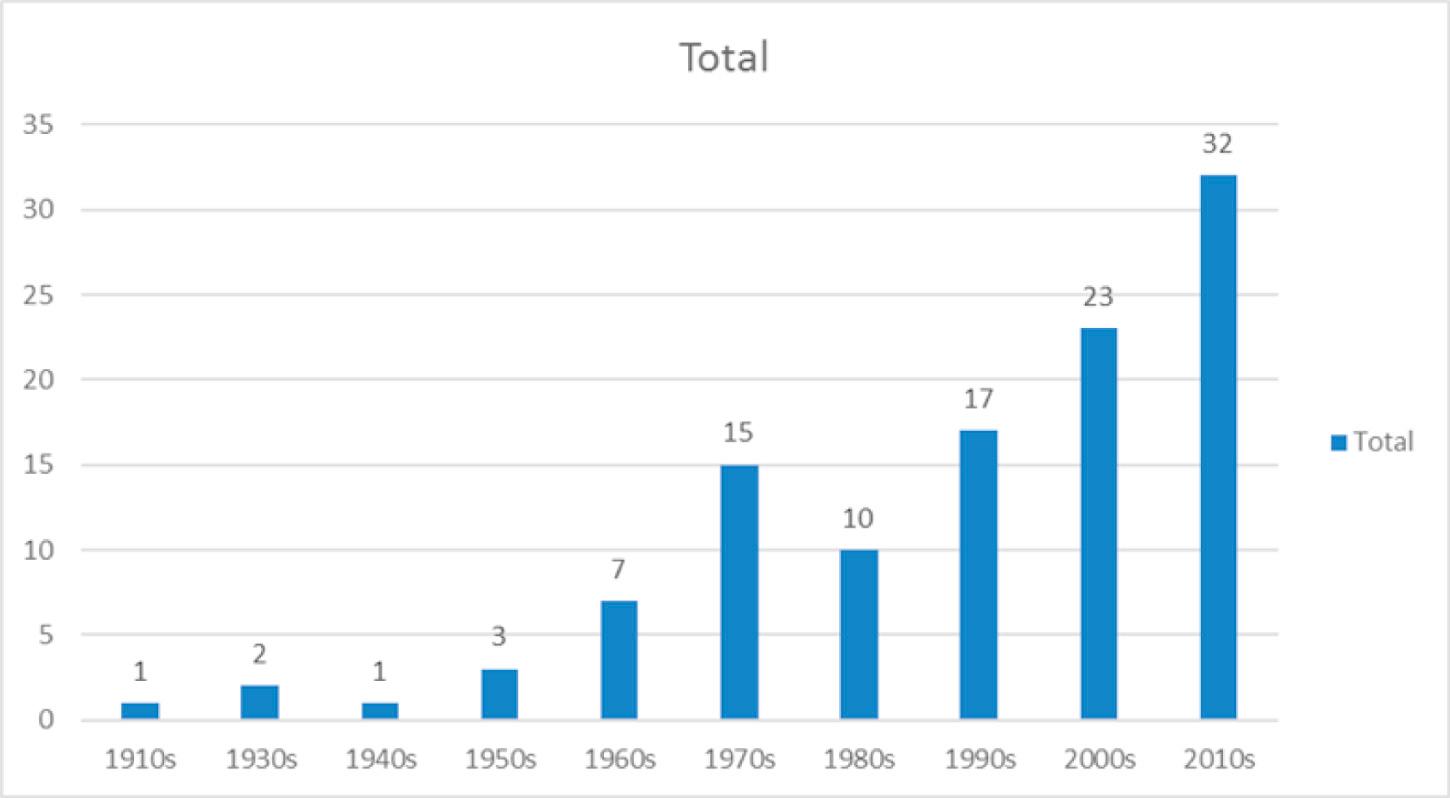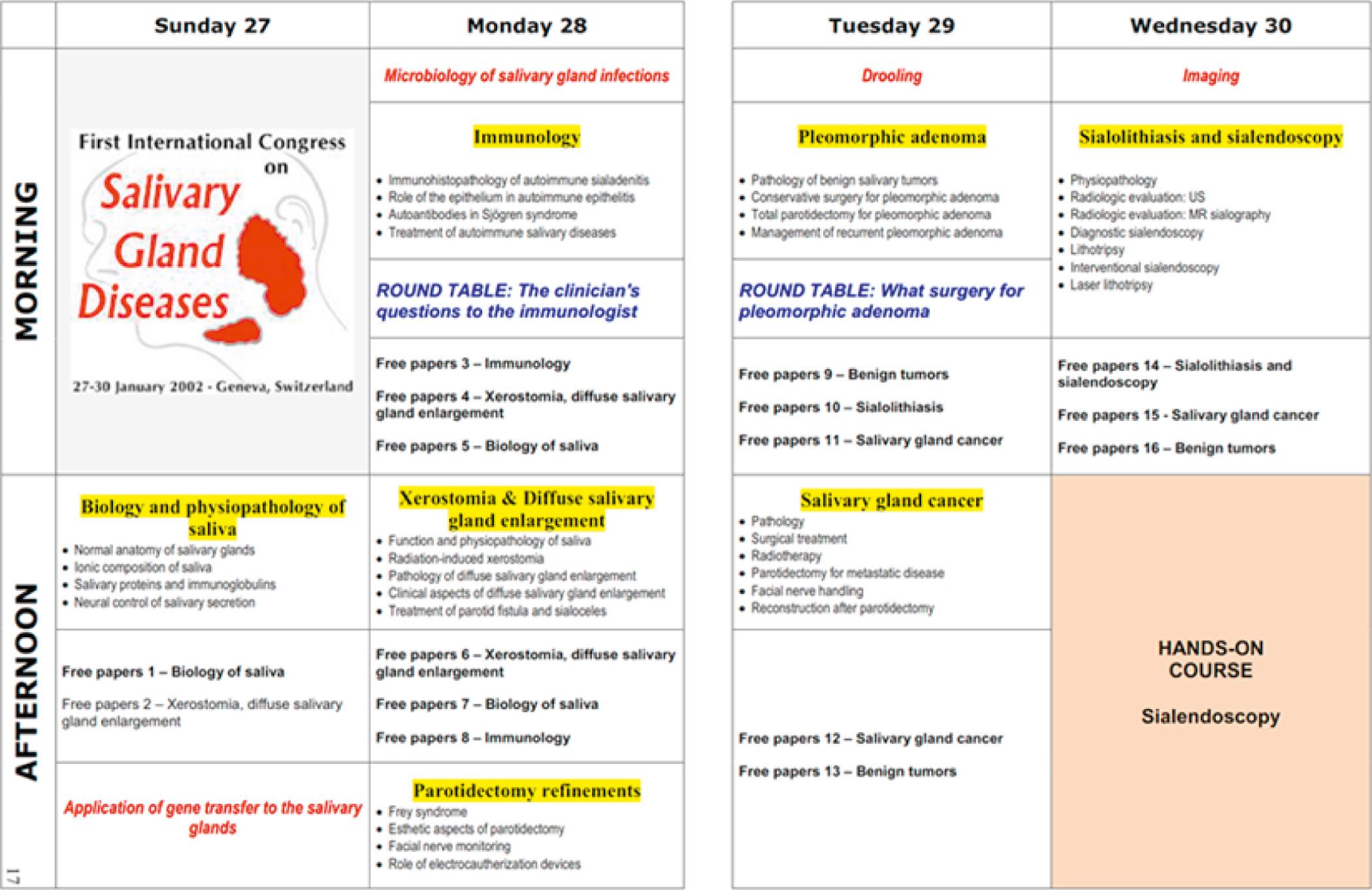Physical Address
304 North Cardinal St.
Dorchester Center, MA 02124
The late 1990s were active in the Department of Otorhinolaryngology – Head & Neck Surgery (ORL-HNS) at the Geneva University Hospital. Dr. Francis Marchal was involved in exploring a completely new field by developing instruments for sialendoscopy and Dr. Pavel Dulguerov had embarked on a Privat Docent thesis on parotidectomy complications. The publications related to these lines of work illustrated that, around the turn of the century, “Salivary Gland Diseases and Disorders” was bound to be an important new field deserving its own meetings and organizations. An example of the growing interest in the field is that half of the books specifically targeting salivary glands or saliva were published after 2000 ( Fig. 58.1 ).

In this context, the Geneva University Department of ORL-HNS decided to organize the First International Congress on Salivary Gland Diseases to be held early in 2002, in Geneva. The meeting had more than 300 attendees, seven plenary sessions, four special lectures, two round tables, 16 free paper sessions with 102 oral communications, and 46 posters.
The idea from the beginning was not only to target surgeons, but to involve any medical or basic science specialty that dealt with saliva or salivary gland problems. Therefore, sessions on physiopathology of saliva, immunology, xerostomia, parotid tumors and cancers, as well as on sialolithiasis and sialendoscopy were included ( Fig. 58.2 ). The meeting continued with the First Sialendoscopy Course organized by Dr. Francis Marchal.

The Second Congress was organized by Dr. Jonas Johnson and Dr. Eugene Myers in Pittsburgh in 2007. The Third Congress was again in Geneva in 2012.
Whereas it was the aim at the outset to organize an International Congress every 5 years, due to logistic and organizational difficulties, the fourth meeting, in 2017, took a somewhat different format, a smaller but truly multidisciplinary 2-day program within the framework of the European Confederation of Otorhinolaryngological Societies (CEORL) meeting. During the General Assembly, in an effort to gather more interested people, to welcome existing salivary gland societies, such as the Japanese and Chinese Salivary Gland Societies, and to underline the multidisciplinary and international aspirations of the society, the European Salivary Gland Society (ESGS) was rebaptized into a “Multidisciplinary Salivary Gland Society” (MSGS). It was also decided that “The Fifth International Congress on Salivary Gland Diseases”, and thus the “First MSGS International Congress on Salivary Gland Diseases” should be held in Philadelphia, USA, in October 2019.
The ESGS is really the creation of Dr. Francis Marchal. The ESGS ( www.esgs.eu ) was incorporated in Geneva in 2006 and held its founding board meeting during the EUFOS (European Federation of Otorhinolaryngological Societies) and The European ORL-HNS Academy Congress in Vienna, in July 2007. The purposes of the ESGS that were coined at the outset remain very relevant and these core aspirations are summarized in Box 58.1 .
Bring together experts or groups of experts – clinicians and researchers from all interested disciplines who have an interest in basic and clinical sciences, as well as diagnostic or therapeutic procedures related to the salivary glands
Exchange and disseminate knowledge and information about basic and clinical science pertinent to saliva, salivary glands, and related disorders
Stimulate basic and clinical research relating to saliva, salivary glands, and their disorders
Develop and promote new technologies to investigate and treat salivary gland diseases
Encourage education, development of high quality training programs, and exchange visits between members
Promote international collaborative studies, prospective databases, and their financing through research grants
Support and cooperate with scientific and educational organizations in related fields
Since its creation, the first President, Secretary General, and Treasurer (2007–2012) were, respectively, Dr. Patrick Bradley (ENT-HNS Nottingham, UK), Dr. Francis Marchal (ENT-HNS Geneva, Switzerland), and Dr. Pavel Dulguerov (ENT-HNS Geneva, Switzerland). Subsequently, following a General Assembly meeting during the International Congress on Salivary Gland Diseases, a second President was found in the person of Dr. Cyrille Chossegros (OMFS, Marseille, France), and the Secretary and Treasurer were asked to continue their tasks (2012–2017). In 2017, Dr. Francis Marchal became the third President, Dr. Vincent Vander Poorten the Secretary General, and Dr. Davide Lombardi the Treasurer. Dr. Eugene Myers (Pittsburgh, USA) was granted the President's Medal of Honour in Barcelona in 2017, in recognition of unremitting support of the Society from its early beginning.
Within ESGS, also the iSIAL (International Society for Sialendoscopy) was created as a subsection, gathering all interested colleagues in the field of sialendoscopy.
Become a Clinical Tree membership for Full access and enjoy Unlimited articles
If you are a member. Log in here